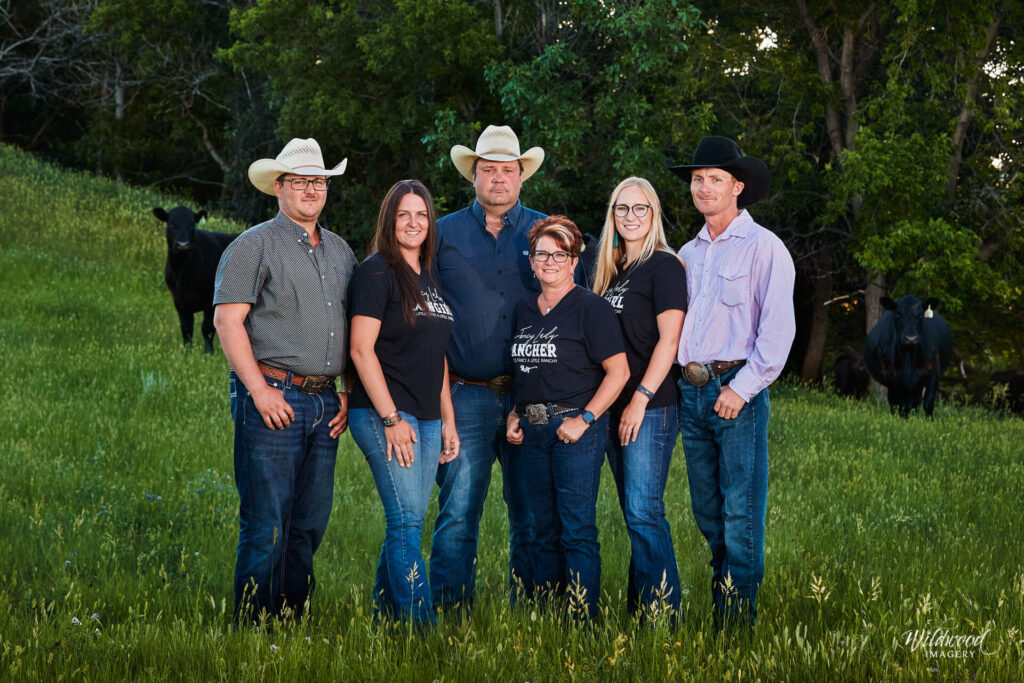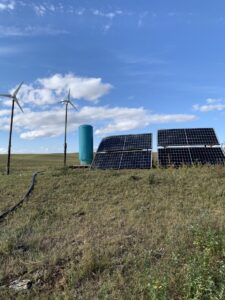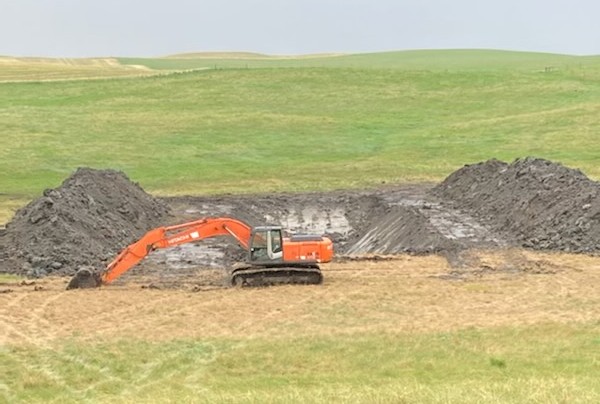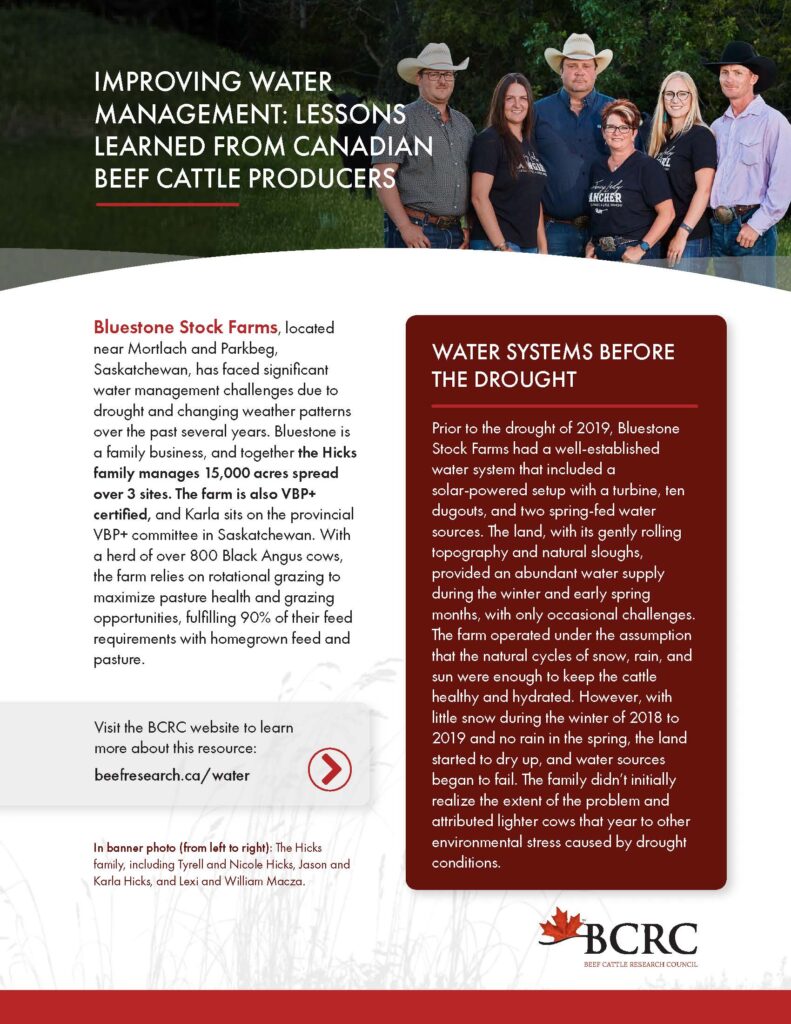Réservoirs de résilience : construire des systèmes de réserve d'eau fiables à travers des années de sécheresse
Bluestone Stock Farms, située près de Mortlach et Parkbeg, en Saskatchewan, a dû faire face à d’importants défis en matière de gestion de l’eau en raison de la sécheresse et des tendances météorologiques changeantes au cours des dernières années. Bluestone est une entreprise familiale, et la famille Hicks gère ensemble 15 000 acres répartis sur trois sites. La ferme est également certifiée VBP+, et Karla fait partie du comité provincial VBP+ de la Saskatchewan. Avec un troupeau de plus de 800 vaches Black Angus, la ferme se fie au pâturage en rotation pour maximiser la santé des pâturages et les occasions de pâturage, comblant 90 % de ses besoins en aliments pour animaux avec des aliments et des pâturages cultivés sur place.

Les systèmes de réserve d’eau avant la sécheresse
Avant la sécheresse de 2019, Bluestone Stock Farms disposait d’un système d’approvisionnement en eau bien établi, comprenant une installation solaire avec une turbine, dix mares-réservoirs et deux sources naturelles d’eau. Le terrain, avec sa topographie légèrement vallonnée et ses marécages naturels, fournissait un approvisionnement en eau abondant pendant l’hiver et au début du printemps, avec seulement quelques défis occasionnels.
La ferme fonctionnait selon la supposition que les cycles naturels de neige, de pluie et de soleil suffisaient à maintenir les bovins en bonne santé et hydratés. Cependant, avec peu de neige pendant l’hiver 2018-2019 et aucune pluie au printemps, les terres ont commencé à s’assécher et les sources d’eau à se tarir. Au départ, la famille n’a pas réalisé l’ampleur du problème et a attribué le poids plus léger des vaches cette année-là à d’autres facteurs environnementaux liés à la sécheresse.
La crise se poursuit
L’hiver suivant (2019-2020), la situation de Bluestone liée à l’eau avait empiré. Les mares-réservoirs et les marécages s’asséchaient, et les faibles chutes de neige hivernales n’ont pas mené à un réapprovisionnement suffisant en eau. L’absence de pluie printanière n’a pas permis de remplir les petits plans d’eau, et même les grands plans d’eau qui n’avaient pas séché depuis des décennies ont commencé à baisser. La croissance des pâturages était clairsemée et aucune trace d’animaux sauvages n’était visible près des plans d’eau, constituant un autre changement par rapport aux années précédentes. Le plus inquiétant était que les bovins montraient des signes de détresse: perte de poids, apparence rugueuse et diarrhée sévère.
La famille a commencé à analyser ses sources d’eau et a découvert des niveaux élevés de sulfates, certaines sources d’eau présentant des niveaux dangereusement élevés, dans la plage de 19 000 ppm, bien au-dessus du seuil de sécurité pour la consommation bovine et causant de graves effets sur la santé. (Voir l’interprétation des résultats d’analyse de l’eau pour les bovins de boucherie pour plus de directives.) En réponse, le ranch a commencé à utiliser des suppléments de minéraux chélatés pour aider à atténuer ces effets et a limité l’utilisation des sources d’eau présentant les niveaux de sulfate les plus élevés.

Innovations dans la gestion des réserves d’eau
Les conditions de sécheresse ont persisté et, en 2021, la situation ne s’était pas améliorée. Les sources d’eau naturelles et les mares-réservoirs n’ont pas été réapprovisionnées en raison du manque de pluie printanière et l’humidité du sol était complètement épuisée.
Déterminée à traverser une nouvelle saison difficile et consciente de l’intérêt à long terme de rendre la ferme plus résistante aux problèmes liés à l’eau, Bluestone a investi dans de nouveaux équipements, y compris une excavatrice, un camion d’eau et trois nouveaux systèmes de réserve d’eau à énergie solaire. Elle a également ajouté des éoliennes et des batteries pour compléter les systèmes solaires en cas de pénurie d’électricité.
La famille transportait chaque jour de l’eau vers plusieurs pâturages, et les vaches et les animaux sauvages affluaient vers le camion d’eau. Onze nouvelles mares-réservoirs ont été ajoutées, chacune conçue pour recueillir l’eau de pluie et fournir une source d’eau fiable pour les bovins, et une source à débit naturel a été agrandie. Bien que ces changements aient permis au ranch de répondre aux besoins en eau des bovins, les nouveaux systèmes et le transport de l’eau nécessitaient un entretien et un travail constants.
En 2022, la famille a connu une autre année difficile, marquée par une chaleur extrême et une sécheresse persistante, mais elle a continué à améliorer ses systèmes en ajoutant trois mares-réservoirs supplémentaires et en perfectionnant ses systèmes existants.

Analyse et surveillance de la qualité de l’eau
Les analyses de la qualité de l’eau sont devenues un élément essentiel de la stratégie mise en place par Bluestone pour garantir la santé de ses bovins. Avant la sécheresse, la famille n’avait jamais envisagé de procéder à des analyses régulières de l’eau, mais la crise l’a poussée à adopter cette pratique. Elle a commencé à analyser plusieurs sources et sites, y compris la même source plusieurs fois par an afin de suivre la détérioration de la qualité de l’eau.
Les analyses ont révélé que plusieurs de leurs sources d’eau présentaient régulièrement des taux élevés de sulfates. Avec l’aide d’un spécialiste en vulgarisation du ministère de l’Agriculture de la Saskatchewan, ils ont pu poser des questions, interpréter les résultats et prendre des mesures pour éviter ou atténuer les effets d’une mauvaise qualité de l’eau.
Des analyses régulières ont permis à la famille de prendre des décisions éclairées quant aux sources d’eau à utiliser et à celles à éviter. Elle a également commencé à mélanger l’eau de mauvaise qualité avec de l’eau de meilleure qualité, acheminée par camion depuis d’autres sources, afin de diluer les contaminants et d’offrir une hydratation plus sûre à ses bovins.
Investir dans la sécurité hydrique pour l’avenir
Un réseau diversifié de marécages, de mares-réservoirs et de sources naturelles, appuyé par des systèmes alimentés à l’énergie solaire et soutenu par des génératrices, assure un approvisionnement constant en eau, quelles que soient les conditions. Cependant, la tâche d’entretenir des sources d’eau éloignées demeure incessante, exigeant à la fois de la prévoyance et de la persévérance.
« C’était un investissement important en peu de temps, mais nous ne le regrettons pas », affirme Karla. « Nous serons riches en eau, et cette tranquillité d’esprit n’a pas de prix. Maintenant, mes petits-enfants seront prêts pour la prochaine. »
À mesure que les tendances météorologiques deviennent plus imprévisibles, Bluestone Stock Farms reste vigilante dans la gestion de ses systèmes de réserve d’eau, continuant à recourir à des analyses de l’eau et aux conseils d’experts. Malgré les défis posés par les étés chauds, des améliorations stratégiques et des connaissances durement acquises ont permis de renforcer la ferme contre le manque d’eau.
Principaux points à retenir en matière de gestion de l’eau
- Des analyses régulières de la qualité de l’eau permettent de détecter des problèmes tels qu’une teneur élevée en sulfates ou une contamination avant qu’ils ne s’aggravent.
- Dans les secteurs caractérisés par des précipitations irrégulières ou la sécheresse, il est essentiel de développer plusieurs sources de réserve d’eau, telles que des mares-réservoirs, des sources et des systèmes alimentés à l’énergie solaire, afin de garantir un approvisionnement fiable.
- Soyez prêt pour l’entretien. Certains systèmes d’abreuvement des animaux d’élevage nécessitent une surveillance et un entretien fréquents afin de garantir leur bon fonctionnement, en particulier pendant les périodes de conditions météorologiques extrêmes.
- Surveillez attentivement la santé et le comportement des bovins. S’ils présentent des signes de déshydratation ou de maladie, vérifiez immédiatement la qualité de l’eau.
- Sachez quand demander de l’aide. Consultez des conseillers, des programmes gouvernementaux et des agriculteurs voisins pour vous aider à prendre des décisions en matière de gestion de l’eau.
Remerciements
Nous remercions les personnes suivantes d’avoir consacré leur temps et leur expertise à la révision de cet article et des ressources connexes :
- Dre Mary-Jane Orr, directrice générale, Manitoba Beef & Forage Initiatives
- Dwayne Summach, spécialiste en vulgarisation sur le bétail et des aliments pour animaux, ministère de l’Agriculture de la Saskatchewan
- Jaclyn Horenburg, spécialiste des relations avec les producteurs, Beef Farmers of Ontario
- Bree Patterson, spécialiste des programmes de conservation – agriculture, Canards Illimités Canada
- Katie Trottier, spécialiste du bétail ruminant, Perennia Food & Agriculture
- Geoff Larkin, coordonnateur de l’adaptation aux changements climatiques, Agri-Commodity Management Association
- Kaley Segboer-Edge, coordonnatrice VBP+ et responsable de l’intendance chez ABP, Alberta Beef Producers
Le partage ou la réimpression des publications du BCRC sont les bienvenus et sont encouragés. Veuillez mentionner le Beef Cattle Research Council, fournir l’adresse du site Web, www.BeefResearch.ca, et nous faire savoir que vous avez choisi de partager l’article en nous envoyant un courriel à [email protected].
Vos questions, commentaires et suggestions sont les bienvenus. Contactez-nous directement ou lancez une discussion publique en publiant vos idées ci-dessous.
